CFdesign v10 Puts Computational Fluid Dynamics Software Upfront
Blue Ridge Numerics' latest computational fluid dynamics solution to improve first-time user experience, extend design study, and support high-performance computing.
Latest News
July 9, 2008
By DE Editors
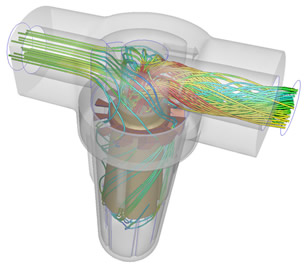 Simulation of a water separator in CFdesign v10. Air flows in through a spur gear, starts to swirl, and creates a funnel effect as it heads towards the outlet leaving the moisture droplets at the bottom of the device. |
Blue Ridge Numerics (Charlottesville, VA) has announced version 10 of CFdesign, its CFD software that provides engineers with CAD-driven tools to optimize fluid flow and thermal performance upfront and early in the digital design phase. A key goal in the development of version 10 was to make the software easier for first-time or modestly trained users without compromising analysis power.
“An engineer with limited or no previous engineering analysis experience can achieve extensive flow and thermal design studies in a fraction of the time it would take most CFD experts,” explains Blue Ridge President Ed Williams. “By knocking down the intimidation-factor, we believe v10 makes it easier for companies to move CFD further upstream in the design process,” precisely when companies can improve product quality, time-to-market, and profitability through the product lifecycle.
So with this software release, CFdesign v10 focuses on shortening the learning curve for first-timers. But it doesn’t stop there. It adds what the company describes as “industrial-strength” problem-solving capabilities, including cavitating flow prediction and thermo-electric cooler analysis, as well as offering an optional HPC module.
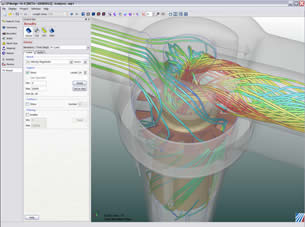 Navigation driven by property tables provides a simple roadmap for setting up, simulating, and extracting solutions for a water separator. |
CAD System Support
In CFdesign v10, users can work from a design approach driven by property tables that are said to ease navigation: set up, launching, and visualizing simulations. The user interface lets the user know what to do, when to do it, and then summarizes what was done.
Blue Ridge Numerics says that because many elements in the v10 user interface were inspired by CAD tools, it leverages familiar paradigms and workflow habits, particularly design review/solution extraction, interactive void filling, and external volume creation. CFdesign v10 uses the intelligence built into the CAD model, including model orientation, part colors, background color, part names, and material properties — even mouse functions are identical. The result, asserts the developer, is an experience that rivals a CAD-embedded solution within an environment that is optimized for flow and thermal design studies.
| “We focused on the total user experience from a first-timer’s perspective. CFdesign v10 is about democratizing fluid flow and heat transfer simulation.” — Ed Williams, Blue Ridge Numerics, president |
For example, CFdesign v10 is said to make it fast and easy to drill into analyses and extract the vital information for decision-making. The new multi-view mode facilitates the review of different analysis results in up to four independent views. Synchronous navigation allows the simulation model in each view to be rotated, zoomed, and explored.
In CFD, all openings (or voids) in a digital prototype must be closed off before conducting an internal flow simulation. Historically this step has been completed within the CAD system. CFdesign v10 provides tools to quickly find and fill voids. Upon completion the flow volume is automatically generated for the user.
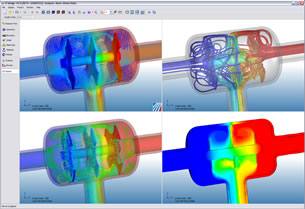 The new multi-view mode facilitates the review of different analysis results in up to four independent views. Synchronous navigation allows the simulation in each view to be rotated, zoomed, and explored. |
Also, an external flow volume representing the environment surrounding a digital prototype is requisite for natural convection and aerodynamic simulations. Instead of asking the user to perform this function in the CAD system, it can now be done within CFdesign v10.
V10 also offers additional CAD system support. Offerings such as overviews, key features, benefits, full details, demos, and FAQs are available as tabbed items in each of the following programs for which CFdesign v10 offers integrated, associative solutions: Autodesk Inventor, CATIA, CoCreate, UGS NX/I-deas, Pro/ENGINEER, SolidWorks Solid Edge, and SpaceClaim (links provided below).*
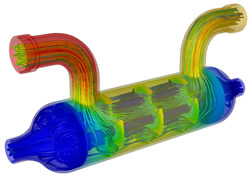 CAD associativity and interactive void filling are features in CFdesign v10 that simplify the design study process for a heat exchanger. |
Flow Innovation & Thermal Management
CFdesign v10 cavitation prediction equips engineers involved in flow control, pumps, and valves with a tool to predict the onset and location of destructive vapor bubbles. The user can then confirm which design changes best mitigate this unwanted and costly physical phenomenon.
Thermal management is broken down into three options in CFdesign: thermoelectric coolers, Quick Forced Convection, and the new Quick Natural/Free Convection. According to Blue Ridge Numerics, engineers who wish to tap into the benefits of thermoelectric coolers (TEC) will gain tremendous insight using CFdesign v10.
Thermoelectric coolers rely on the Peltier effect. When a current is run through a thermoelectric device, heat is transported from one side of the device to the other. CFdesign v10 includes a library of manufacturer-supplied TEC components to choose from — but users can also define a new component using the material editor.
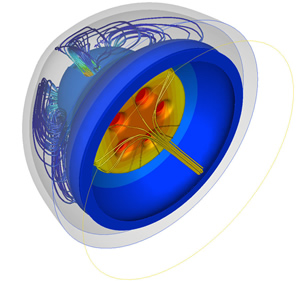 The new Quick Natural Convection functionality in CFdesign V10 will be of great benefit to design engineers wishing to integrate LED lighting into their product, according to Blue Ridge Numerics. |
A second option in CFdesign v10’s ability to handle thermal management is the Quick Forced Convection option, which offers a practical approach for engineers to conduct early trend analyses during design sketch and concept design phases. This new tool uses a proprietary technique that assumes an incompressible, ideal fluid and then automatically computes empirical film coefficients and solves for the heat transfer. In this way, an engineer can interact with colleagues and consider dozens of scenarios involving a full spectrum of potential physical designs and operating conditions within the context of a single design review meeting.
CFdesign v10’s new Quick Natural/Free Convection option provides engineers with a view into design-specific natural convection dynamics. Considered one of the most computationally intensive CFD simulations, natural convection cases can sometimes be too time-consuming for design engineers working upfront in the product development process.
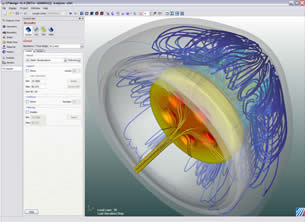 Simulation results from a Quick Natural Convection on LED light design shown with CFdesign v10 new user interface. |
This new option in v10 speeds the process by running a small number of flow and thermal iterations together, accounting for the surrounding fluid before computing and applying film coefficients. From there the simulation continues as a thermal-only analysis, providing timely insights that can help keep projects on schedule.
HPC & OSes
With the release of v10, CFdesign is now available with an optional HPC module that significantly decreases the time required to achieve flow and thermal solutions. The new module distributes the computational load of CFD simulations across a cluster of processors networked by a Microsoft Windows HPC Server. Plus, CFdesign v10 operates on Windows XP 32, XP 64, Vista 32, and Vista 64.
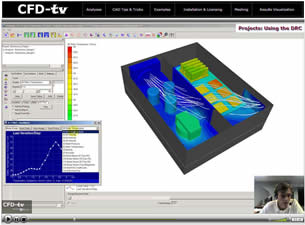 CFD-tv from Blue Ridge Numerics provides CFdesign v10 users with on-demand, task-specific training in a Web 2.0 format. Each CFD-tv episode is a “quick hit” video segment led by a CFdesign power user. New training segments will be added continuously to answer commonly asked questions. |
Demonstrations via CFD-tv
With this latest release, current CFdesign customers can access a suite of functionality specific v10 demonstrations on Blue Ridge Numerics’ CFD-tv within the CFdesign customer portal.
Described by the company as an industry first, CFD-tv provides users with on-demand, task-specific training in a Web 2.0 format that should appeal to multi-tasking engineers who want CFD to be a tool and not a career.
Each CFD-tv episode is a “quick hit” video segment led by a CFdesign power user. New training segments will be added continuously to answer commonly asked questions, according to Blue Ridge Numerics.
Learn more about v10 of Blue Ridge Numerics’ CFdesign upfront CFD software.
Read why DE’s editors chose CFdesign v10 as a Pick of the Week.
View Blue Ridge Numerics’ On-Demand Demos.
A personalized demonstration can be arranged by contacting a CFdesign sales office.
Or play the Applications Examples Video from the Applications page.
* CFdesign v10 is available as an integrated, associative solution for the following eight programs:
Subscribe to our FREE magazine, FREE email newsletters or both!
Latest News
About the Author
DE’s editors contribute news and new product announcements to Digital Engineering.
Press releases may be sent to them via [email protected].






